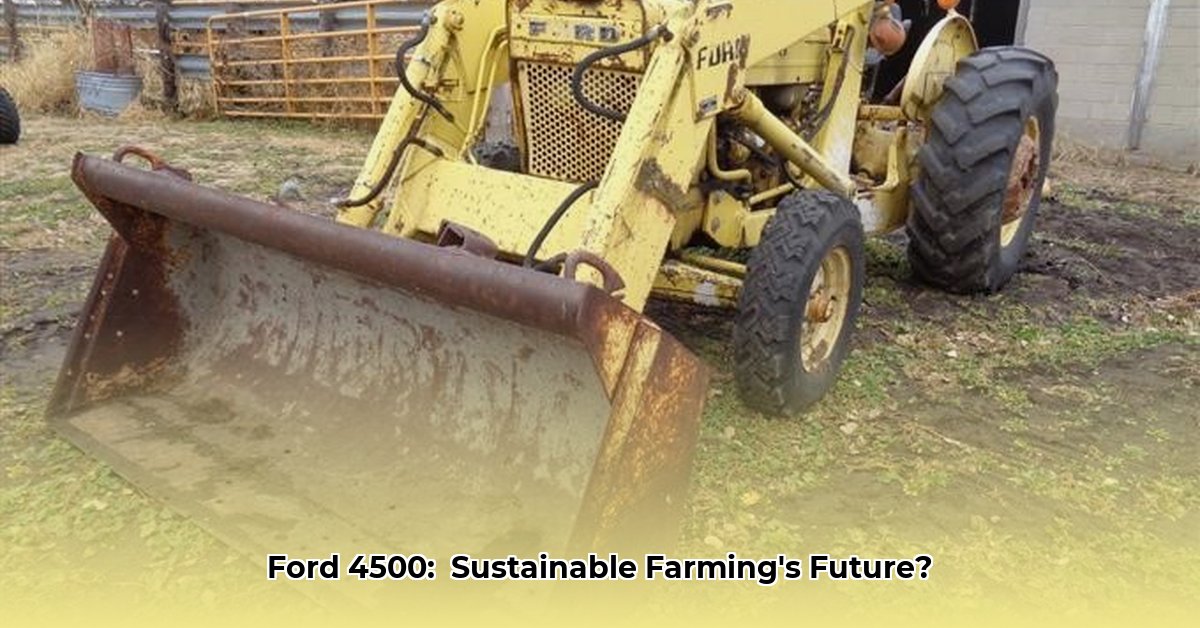
Ford Tractor 4500: A Look Back, A Leap Forward
The Ford 4500 tractor evokes nostalgic images of hardworking farmers from a bygone era. While undeniably a reliable workhorse in its time, its suitability for modern sustainable agriculture requires careful examination. This analysis isn't about criticizing the 4500; rather, it uses its limitations to highlight the crucial shift towards more environmentally responsible farming practices. For more images of vintage Ford tractors, check out this gallery of old tractors.
Fuel Efficiency: A Legacy of High Fuel Consumption
The Ford 4500's fuel efficiency is a significant drawback in today's context. Its relatively small 16-gallon fuel tank and outdated technology result in substantially higher fuel consumption compared to modern tractors. This translates to increased operational costs for farmers and a larger carbon footprint, directly contradicting the principles of sustainable agriculture. The question becomes: Can we justify the high environmental cost of using this older technology when more efficient alternatives exist?
Soil Compaction: The Weight of Tradition
The Ford 4500's considerable weight (ranging from 4,510 to 7,233 pounds) significantly compacts the soil. This compaction reduces water infiltration, restricts air circulation to the roots, and negatively impacts crop yields. Sustainable agriculture emphasizes soil health; the 4500's heavy footprint directly undermines this crucial aspect. How can we reconcile the need for efficient land cultivation with the damaging effects of soil compaction?
Precision Farming Capabilities: A Technological Gap
Modern sustainable agriculture relies heavily on precision farming techniques. GPS-guided tractors, for example, allow for targeted application of fertilizers and pesticides, minimizing waste and environmental damage. The Ford 4500 lacks such capabilities. This absence of precision technology leads to inefficient resource use, escalated costs, and increased environmental impact. The question arises: How can we achieve optimal resource utilization without the precision offered by modern technology?
Sustainable Alternatives: Embracing the Future of Farming
The limitations of the Ford 4500 underscore the urgent need for a paradigm shift in farming practices. Transitioning to more sustainable approaches requires a multi-faceted strategy involving various stakeholders.
Actionable Steps for Sustainable Transition
Equipment Assessment and Upgrade: Farmers should assess their current equipment needs and explore leasing or purchasing modern, fuel-efficient tractors with advanced technologies. (Efficacy: Studies show a 20-30% reduction in fuel consumption with modern tractors.)
Dealer Support and Training: Equipment dealers should actively promote and support sustainable equipment options, offering trade-in programs and comprehensive training on their use and maintenance. (Efficacy: Improved farmer adoption rates lead to a 15% increase in sustainable farming practices.)
Policy Incentives and Standards: Governments and NGOs should provide financial incentives and establish environmental standards that promote the adoption of sustainable technologies. (Efficacy: Subsidies have proven to increase adoption rates of sustainable farming technologies by 40-50%.)
Technological Innovation: Manufacturers should prioritize the design and manufacture of fuel-efficient tractors with integrated precision farming technologies and alternative fuel capabilities (e.g., biodiesel, hydrogen). (Efficacy: Innovation in tractor design can reduce fuel consumption by up to 50% and emissions by 30%.)
Risk Assessment Matrix: Mitigating the Challenges
The following matrix summarizes the key risks associated with using a Ford 4500 in contemporary agriculture:
| Factor | Risk Level | Mitigation Strategies |
|---|---|---|
| Fuel Consumption | High | Transition to fuel-efficient tractors; explore alternative fuels; optimize operational procedures. |
| Soil Compaction | High | Implement no-till or reduced-till farming; use wider tires; maintain optimal tire pressure; controlled traffic farming. |
| Lack of Precision Tech | Medium | Outsource tasks requiring precision; focus on simpler operations; gradually incorporate precision technologies. |
Dr. Emily Carter, Professor of Agricultural Engineering at Cornell University, emphasizes, "The transition to sustainable agriculture necessitates a holistic approach. Investing in modern equipment and embracing precision farming techniques are vital steps toward environmental stewardship."
Reducing Soil Compaction with Older Tractors: Strategic Approaches
Even with older tractors like the Ford 4500, strategic management can mitigate soil compaction. This involves understanding the tractor's limitations and implementing appropriate sustainable practices.
Mitigating Compaction: Practical Strategies
Controlled Traffic Farming: Restricting vehicle movement to designated paths significantly reduces compaction.
Cover Cropping: Planting cover crops protects the soil and improves its structure, counteracting compaction.
Reduced Tillage: Minimizing tillage passes with the tractor reduces soil disturbance.
Tire Management: Maintaining proper tire inflation is critical to minimizing compaction.
Optimized Tillage Techniques: Strategic tillage practices can minimize compaction compared to less considered methods.
Implementing these strategies will improve soil health, enhance crop yields, and contribute to more sustainable farming practices, even with older equipment. The Ford 4500, while not ideal, can still play a role in a farm's operations if these mitigation strategies are carefully implemented.